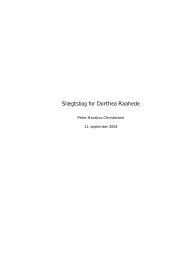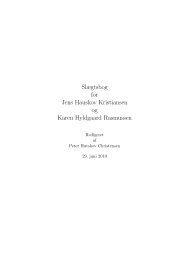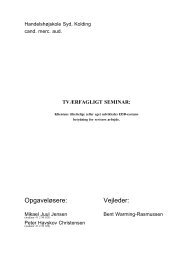PDF uden ophavsretligt beskyttede sider - Peter Havskov Christensen
PDF uden ophavsretligt beskyttede sider - Peter Havskov Christensen
PDF uden ophavsretligt beskyttede sider - Peter Havskov Christensen
Create successful ePaper yourself
Turn your PDF publications into a flip-book with our unique Google optimized e-Paper software.
– hvilke revisionsomr˚ader, der berøres af edb-anvendelsen,<br />
– om der skønnes at være behov for assistance fra personer med specialviden,<br />
– muligheden for eventuelt at anvende edb som hjælpemiddel ved revisionen.<br />
6. Auditing with the computer<br />
Kun sidste punkt vedrører indgangsvinklen “with”. Dette er ikke meget opmærksomhed, at give et s˚a væsentligt<br />
omr˚ade. I mangel af dansk vejledning p˚a omr˚adet anvender vi s˚a den internationale revisionsvejledning<br />
ISA nr. 16, som er gengivet p˚a <strong>sider</strong>ne 69 til 76.<br />
6.5.1 International Standard on Auditing 16<br />
Paragraphs<br />
Introduction 1-3<br />
Description of Computer-Assisted<br />
Audit Techniques(CAATs) 4-6<br />
Uses of CAATs 7<br />
Con<strong>sider</strong>ations in the Use of CAATs 8-16<br />
Using CAATs 17-23<br />
Using CAATs in Small Business<br />
Computer Environments 24<br />
Introduction<br />
1. The overall objectives and scope of an audit do not change<br />
when an audit is conducted in an EDP environment as<br />
defined in International Standard on Auditing (ISA) “Auditing<br />
in a Computer Information Systems Environment”; however,<br />
the application of auditing procedures may require the<br />
auditor to con<strong>sider</strong> techniques that use the computer as an<br />
audit tool. These various uses of the computer are known as<br />
Computer-Assisted Audit Techniques (CAATs).<br />
2. ISA “Auditing in a Computer Information Systems Environment”<br />
discusses some of the uses of CAATs as follows:<br />
– The absence of input documents or the lack of a visible<br />
audit trail may require the use of CAATs in the<br />
application of compliance and substantive procedures.<br />
– The effectiveness and efficiency of auditing procedures<br />
may be improved through the use of CAATs.<br />
3. The purpose of this Standard is to provide guidance in the<br />
use of CAATs. It applies to all uses of CAATs involving a<br />
computer of any type or size. Special con<strong>sider</strong>ations relating<br />
to small business computer environments are discussed<br />
in paragraph 24.<br />
Description of Computer-Assisted Audit Techniques<br />
(CAATs)<br />
4. This Standard describes two of the more common types of<br />
CAATs; audit software and test data used for audit purposes.<br />
However, the guidance provided in this Standard applies to<br />
all types of CAATs.<br />
Audit Software<br />
69<br />
Første del af dette punkt svarer til pkt 1.1 i RV 14<br />
og RV 17. Om nødvendig kan begrunde brug af<br />
CAATs se afsnit refnoedvendighed





